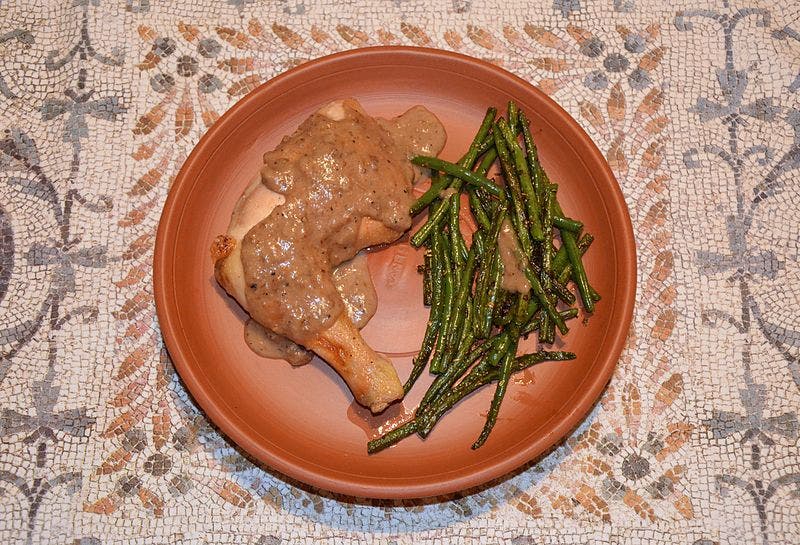
Perhaps one of the most underappreciated aspects of archaeology is cooking. We know surprisingly little about how people used to cook in ancient times, although a few delicious recipes managed to slip through the cracks and remain recorded. Such is the case with Pullum Numidicum (Numidian Chicken), a simple, delicious and authentic Roman recipe.
The dish
Chicken was a staple of Roman cooking, and chickens accompanied armies in their campaigns. Now, some of the ingredients may be hard to find and the preparation technique won’t be the same (I assume you’d be cooking this in a modern kitchen), but the gist of it will remain.
Here’s the recipe, as we know it today:
Pullum numidicum: pullum curas, elixas, leuas, laser ac piper et assas. teres piper cuminum coriandri semen laseris radicem rutam careotam nucleos; suffundis acetum mel liquamen et oleum; temperabis. cum ferbuerit, amulo obligas, pullum perfundis, piper aspergis et inferes.
Christopher Grocock and Sally Grainger, Apicius, 230
This translates into:
Numidian chicken: prepare the chicken, parboil it and lift it out, asafoetida (lasere) and pepper and roast it. Pound pepper, cumin, coriander seed, root of asafoetida, rue, dates, pine nuts; pour in vinegar, honey, liquamen and oil; balance the flavours. When it comes to heat, thicken with starch, pour over the chicken, sprinkle pepper and serve.
Ingredients (serves 4)
Firstly, you need:
- 1kg chicken pieces
- Asafoetida powder
- Pepper
Asafoetida powder may be a bit tricky to find. The species is native to the deserts of Iran and mountains of Afghanistan and is mainly cultivated in nearby India, so try searching for it in oriental shops. It has a fetid smell, but when cooked delivers a smooth flavour reminiscent of leeks. It is also a flavor enhancer and a key ingredient in the dish. If you can’t find any, rosemary is also OK.
For the sauce:
- 1/2 tsp freshly-ground black pepper
- 1/2 tsp cumin seeds
- 1/2 tsp coriander seeds
- pinch of asafoetida pinch of rue (or rosemary)
- 4 tbsp dates, finely chopped 4 tbsp
- ground almonds or hazelnuts
- 1 tbsp white wine vinegar
- 1 tbsp honey
- 200ml chicken stock
- 1 tbsp honey
- 2 tsp olive oilfreshly-ground black pepper, to garnish
- freshly-ground black pepper, to garnish
- 2 tsp wheat starch to thicken (wheat flour can also be used, or you could not use anything at all if you don’t want to thicken the sauce).
Cooking instructions
The first thing you should do is put the chicken into boiling water. You should leave it about 30 minutes to parboil, and then dry it (keep the broth). After it’s dry, place it on a roasting tin (if possible) and sprinkle some black pepper and asafoetida on it. Then, place it in the pre-heated oven at 180C and roast it for about 40 minutes (until it’s properly cooked).
While the chicken is boiling, it’s time to focus on the sauce. Gently heat and dry-fry together black pepper, cumin, coriander seeds, asafoetida until they are fragrant. Be careful not to burn them. Afterwards, grind them as the Romans would have done. Add the dates and ground nuts and keep pounding them together. Work in the vinegar and honey until everything is a consistent paste, and then chicken stock and olive oil. If you want to spare yourself some trouble, simply grind everything together in a food processor. After everything is mixed together satisfyingly, put them in a pan until they’re boiling, and it’s all done.
Enjoy this delicious ancient recipe from the Roman empire!






